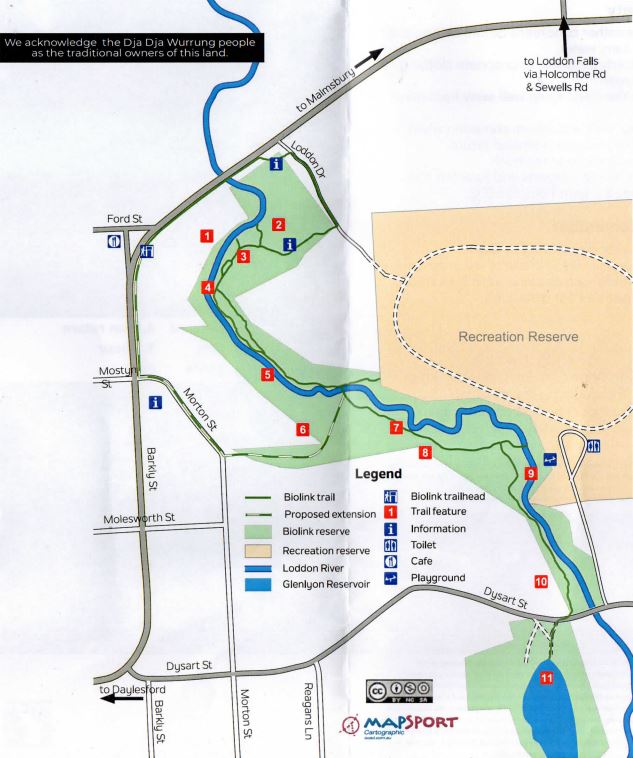Glenlyon - Biolink Walk

The Biolink walk is an easy 4.6 km return, 1.5 hour walk.
Biolink Walk Map

The Glenlyon Biolink meanders alongside the Loddon River at Glenlyon, from Loddon Drive to Dysart Street. Sometimes the river is full and fast flowing, at other times only the occasional puddle or spring is evident. Always there is something to see or hear.
Alongside the trail is the Glenlyon Recreation Reserve and Mineral Spring - lovely spot to 'take the waters'. There is ample parking, picnic tables and chairs, with public toilets and access to a BBQ.
Historic Sites Along the Trail
1. Site of flour mill and water wheel pit. The mill ran from 1873-1886. It's closure was due to the statewide drought which lasted from 1880-1886, resulting in lack of water and crop failures.
2. Site of former river crossing. There are still a few cobblestones visible. This was the only way to cross the Loddon before the first bridge was build in 1864. The track came down the hill beside the present road, along the bottom and wound up to Loddon Drive.
3. Site of a pine plantation planted by Glenlyon School pupils circa 1956 with the purpose of selling the mature timber and earning money for the school.
4. Remains of a weir built by Jack and George (Curly) Dixon to irrigate their potato patch circa 1950s. George Dixon was a WWI veteran. Above, former bluestone quarry: Quarry Reserve.
5. Site of gravel pit owned by the Fleischer family. The Shire Council used the gravel for road metal and local women collected pipe clay to whitewash their fireplaces. Ian collected it to whitewash the Hall fireplaces.
6. The gate up the hill marks a former entrance to the reserve. It is proposed to restore the track and use it again.
7. The river has changed course many times due to flooding, fallen trees, debris etc. Traces of the old course are still visible.
8. The small gate up the hill used to be the access from Molesworth Street, via a turnstile. Another turn-stile was situated at the Loddon Drive entrance.
9. Weir and swimming pool. In the 1950s and 60s Glenlyon kids learned to swim in this pool. Those who were older and more competent swam in the dam. The wall of the weir was raised in later years.
10. Here one can see the traces of the water race along the west side of the track, against the base of the hill.
11. Glenlyon Dam was originally constructed circa 1875 to supply water to the flour mill. It now serves the community as a recreational and emergency water supply. Traces of a former fish hatchery can be seen on the east side. Below the present dam wall is the location of the beginning of the water race. The road had a different configuration in years gone by; the present gravel entry and concrete pad were non-existent and fire trucks used a track nearer the bridge and parked below the dam wall to fill up.
Information and map by Ian Fleischer and the Glenlyon Upper Loddon Landcare Group
Walk Safety
- Check weather conditions before setting out.
- Always carry water.
- Wear sturdy footwear, appropriate clothing & sunscreen
- Stick to the track. Keep well away from mine shafts.
- Plan your walk and inform someone where you are going and your intended return.
- Never walk alone in the bush.
- Observe fire regulations and total fire bans.
- If you need urgent help, call 000.
Please Remember
- Take any rubbish when you leave.
- All native animals and plants are protected, as well as relics such as stone walls & old huts.
Access for Dogs:
Dogs must be kept on a leash.
Location
Loddon Drive, Glenlyon 3461 Map









